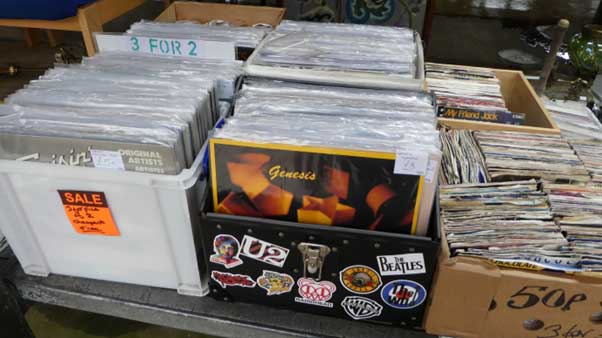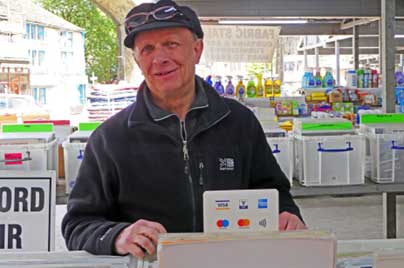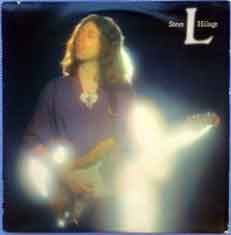
Some non-linear thoughts from Alan Dearling
Many of us fall into two categories: hoarders & collectors, or, minimalists & throwers, the chuckers-out. I realised very early on in life that I’m a natural-born squirrel. I like to collect, to nourish my life with knowledge and new stuff, whether it is books or music. And my earliest music purchases were 78s on thick, easily cracked wax. That was at the end of the 1950s. Then it was 45s and 33s – singles and eps (extended play singles) and albums. They were vinyl. Alongside that, a lot my music-besotted generation acquired tape-recorders, known by the cognoscenti as open-reel machines, at the top-end made by companies like Revox, Ferrograph and Tandberg.
My student years were in the sixth form in West Sussex and at universities in Kent and London – a lot of us immersed ourselves in live musical experiences. Live gigs and the early festivals. We also amassed, if you like, ‘collected’ hi-fi (high-fidelity) equipment – turntables, cartridges, loud-speakers and amps from an amazing range of really rather fabulous manufacturers, such as Thorens, SME, Quad, Leak, Rogers, Goodmans, KEF, Neal, Nakamichi, Harmon-Kardon, Armstrong and more.
Then in 1970s came cassettes. Pretty poor audio quality with lots of sound drop-outs, especially on the pre-recorded products, which were manufactured as high-speed copies. Certainly the audio quality was inferior compared with vinyl, despite their propensity to get scratched and suffer from pressing faults, like pops and crackles. Compact Discs (CDs) came next. A lot of older albums were re-mastered, often with extra tracks. These became collectible too.
Now, since the 2000s, there’s streaming. Single tracks are more frequently downloaded rather than whole albums. Some streaming services charge differential rates depending upon the download quality of the audio. Many music fans, even older ones like myself, create and use playlists (and random play) made up by themselves or sourced online. There’s a lot of services like Spotify and Amazon to feed this new market and passion. But vinyl has been more resilient than initially expected. Established and new bands have returned to getting their ‘product’, their ‘merchandise’ pressed on vinyl, and in some cases even on revitalised strangely trendy, cassettes. CDs are no longer de rigeur!

So why and what is crate-digging?
It seems to me that there are many typologies of crate-digger. Our motivations are remarkably varied. Some of this relates to our personal relationships with the music on vinyl, CDs and cassettes. Have you ever wondered about your own musical collecting habits? Do you compare and contrast, and exchange your experiences of ‘crate-digging’, with friends and musical mates?
Completists – filling musical gaps in collections by particular artists, labels etc.
Genre-hunters, such as prog-rock, modern jazz, metal, blues, folk, rap et al.
Artist-hunters – the search for the rare, the extraordinary almost mythical recording
Samplers and music producers, djs and mixers
Collectors for financial gain – and the sub-category of collectors – those who seek to acquire the most obscure, valuable and rare ‘specimens’ as ‘investments’
Discoverers, seekers – looking for new artists, sounds and musical inspiration
I’m mostly in the ‘discoverer’ category, plus instances of gap-filling, random ‘finds’ and purchasing new mixes and formats of old music. And on occasions, I hunt out artists who have often played live gigs I want to hear, or, have performed on sessions with musical friends.
The ‘what is crate-digging’ conundrum has become more complicated (perhaps?). It’s an example of supply and demand economics. On the supply side, below is an attempted draft diagram of some of the locations ‘where’ modern crate-diggers may find their musical fare. I’m sure I will have missed some. At a personal level, I have lots of charity shops, record stalls in markets and a fair few music/record shops near where I currently live. But, I already almost have too much vinyl. An almost heretical admission for many music collectors! However, I find the portability of CDs and these days their improved sonic audio quality is useful as I move between different sound systems and locations. So, many of my purchases are in the CD format. But I review a fair amount of vinyl releases too. I also have a full Spotify subscription which I use to try out new music and check out obscure sounds.


Crate-digging’ is often a sensual pleasure. More of an art than a science, though there are ‘bodies of knowledge’ and decision-making processes behind our searches and purchases. At least some of the time! Perhaps it is (for different individuals), a mix of passion, impulse and compulsion to ‘search’ for a particular real or imagined musical nirvana. Perhaps!?! We live in an ever-optimistic state, hopeful of hitting the seam of gold, or at least a few nuggets. This week I discovered a Willie Nelson album produced by Don Was, ‘Across the Borderline’. Definitely full of enough ‘nuggets’ to make crate-digging worthwhile. There’s a Dylan duet and co-write with ‘Heartland’ and a beautiful version of Peter Gabriel’s song, ‘Don’t give up’, with Sinead O’Connor sharing vocal duties with Willie: The video is the short version: https://www.youtube.com/watch?v=gO6fAJcN89k
There’s Bonnie Raitt, Paul Simon and Kris Kristofferson on there too. Much of it is absolutely drop-dead gorgeous!

The music stalls in my local markets on Thursday and Sunday at the Todmorden Market in West Yorkshire are one readily available hands-on supply source for me, though there is much more vinyl on offer than other formats. But it also provides some music books sometimes too. Premier Music Fairs’ Mel is a regular stall holder on Thursday, and Heightside Records on a Sunday. In addition, both are regulars at Record Fairs.


As a discoverer, a ‘new-to-me’ music seeker, and on-line reviewer, I do receive a fair number of review copies and music from musician friends of newly released music. My crate-digging falls most frequently into two categories:
Targeted searches for specific ‘wants’, particular albums, music by artists who I am interested in. Sometimes it is akin to a quest on an Ancestry or a musical Family Tree!
Random acquisitions. These appeal at all sorts of head and heart levels. It can include, a particular musician, perhaps only featured on a track or two; musical genres and countries and cultures of origin; cover designs; the descriptions included in the package; historical provenance – a situated place in time.
Here are two examples of random purchases from one of my local music shops, Revo Records in Halifax. I would not have discovered them by proactive searching – definitely a case of random crate-digging in the music racks.

- Tony Joe White: The Beginning (2001). The cover is stark monochrome. Stripped-back like the music itself and the playing. It’s late Tony Joe, solo, back to basics, heavily blues-oriented, but almost entirely written by the artist. Sleeve notes say: ‘ voice, guitar, harmonica and foot’. Really enjoyed it for many of the lyrics which made me smile, and the clear, clean playing style and uncluttered production. Apparently it was TJW’s 29th solo album! You might also remember him for the songs he wrote, such as ‘Steamy Windows’ for Tina Turner.
Here’s an example of his swamp blues live: https://www.youtube.com/watch?v=foi7O42KHcQ

- Kenny Garrett: Beyond the Wall (2006). The photo on the cover of the Wall in China is striking. The line-up of musicians is something of a roll-call of modern jazz, including the sax-playing of Pharaoh Sanders and vibes from Bobby Hutcherson. And from the cover info it looked as though it was going to allow the artists to explore the musical frontiers between jazz and ‘world’ music. It does. It’s challenging, a mix of the melodic and the more discordant. ‘Tsunami Song’ which melds into ‘Kiss the Skies’ are just beautiful:
https://www.youtube.com/watch?v=1hvDeRaNkSQ
I’d missed this album in real time. It was nominated for the Grammy award as Best Jazz Instrumental album of 2007.
Targeted search. I offer one example of a rather personal complex search process that’s still in progress! This is an almost embarrassingly anorak-affair…


I was at the University of Kent (UKC) 1969-72. We didn’t exactly realise that we were in the midst of what has become known as the ‘Canterbury Scene’. But hey, there were really quite a lot of musos and bands living and playing on the campus and in the immediate vicinity. Many members of these bands were my student and Canterbury contemporaries, such as Max Hole (manager for Spirogyra, he latterly became CEO of the Universal Music Group), Richard and David Sinclair, Steve Hillage (pictured), Pye Hastings, Barbara Gaskin, Pip Pyle (Khan, Gong, Hatfield and the North and the National Health) and more. I saw many of these bands associated with the UKC play ‘live’, not always at the university. Caravan, Spirogyra and Hatfield and the North, The Egg and Gong amongst them. But many, many other musicians and bands played on the UKC collegiate campus such as Family, Groundhogs, Fleetwood Mac, Hawkwind, Dr Strangely Strange, Steeleye Span, Quintessence, Al Stewart, Fairport Convention, The Who, Chicken Shack, Babe Ruth, Nico and Led Zeppelin, to name but a few!



I bought my fair share (or what a student grant could stretch to!) of albums during those three years in Canterbury. We swapped albums, put up ‘For sale and wanted’ notices on the student advertising boards. Two LPs that I definitely bought were ‘St Radigund’s’ from the jazz-inflected folk-rock outfit, Spirogyra, which included Barbara Gaskin, Steve Borrill, Julian Cusack, Mark Francis and Martin Cockerham amongst their members. Dave Stewart (not the Eurythmics one), Steve Hillage, David and Richard Sinclair, Max Hole and Pip Pyle were very much central players in this Canterbury musical melting pot. But probably it was Caravan which emerged pre-eminent. They were quite a pervasive music force on the UKC campus, and the cover of their vinyl album, ‘Land of Grey and Pink’ was seen everywhere. They are still viewed as being one of the originators of ‘prog’ (progressive rock), along with the likes of Camel, Rare Bird and Atomic Rooster, who are often added into the ‘Canterbury Scene’, though I don’t believe that they were really part of it, in any significant way, but may have performed there. It’s a long time ago now!
However, the ‘Canterbury Scene’ had begun before my arrival in 1969. The Wilde Flowers’ members lived and grew up around the city and pre-dated the Soft Machine. Their influences were still apparent as the ‘60s gave way to the 1970s decade. There had been an ever-changing roster of Wilde Flowers. Daevid Allen went on to form Gong, Kevin Ayers often joined Daevid in musical enterprises and sojourns in the Balearics at Deia, and went on to create an illustrious and no less quirky musical career. Members of the ‘Softs’: Robert Wyatt, Mike Ratledge and Hugh Hopper became mainstays of a variety of jazz-rock outfits.
Until his untimely demise, I kept in occasional contact with Daevid and he contributed to a couple of my books including ‘Alternative Australia’. In Oz he considered himself primarily as poet, rather than a muso. This photo is of him as a street performer around Byron Bay, where I met up with Daevid and performed with him on a couple of occasions. My own musical writing and photography have also allowed me to coincide fairly frequently with Steve Hillage solo, with System 7, and with his Steve Hillage Band.



Now for the targeted ‘crate-digging’ element. I don’t want to attempt to buy all the records associated with the Canterbury Scene, but I am in the act of potentially searching out and maybe buying records from Khan, The Egg, Hatfield and the North and the National Health. I already have many from Steve Hillage, Gong and some from Henry Cow. So, here’s a ‘toast’ to “On-going crate-digging”, along with discovering more titbits of information regarding the lives of my old Canterbury contemporaries…
